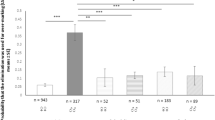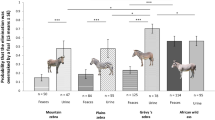Abstract
Whereas most studies on overmarking in mammals analysed the rate of overmarking, that those investigate time between exploration of an olfactory stimulus and the response to it remain less common, with inconsistent results. We examined the latency in time between elimination by the sender and sniffing by the receiver, and from sniffing and overmarking, in four captive African equid species to explore differences among species, and among age and sex classes. We investigated these latency time periods in light of three potential hypotheses explaining overmarking behaviour in equids: social bonds, group cohesion, and intrasexual competition. Analysing 1684 events of sniffing and 719 of overmarking among 130 individuals, we found that (i) the time from elimination to overmarking was shorter among female friends and in parent–offspring dyads, proving support to the social bond hypothesis; (ii) intraspecific differences in time periods do not reflect the social organisation of species, thus not supporting the group cohesion hypothesis; (iii) males were more attracted to elimination of conspecifics than females, and female’s eliminations were inspected longer, in line with the sexual competition hypothesis and/or reproductive behaviour. In addition, we found that the younger foals came to sniff eliminations faster than older ones, and in larger groups foals devoted longer time to sniffing the elimination before overmarking. We concluded that examination of the elimination could be driven by motivations other than the decision to overmark. Whereas overmarking serves to express bonds to a familiar individual, the latency of overmarking reflects more reproductive interests.





Similar content being viewed by others
References
Altmann J (1974) Observational study of behaviour: sampling methods. Behaviour 49:227–267
Black-Décima P, Santana M (2011) Olfactory communication and counter-marking in brown brocket deer Mazama gouazoubira. Acta Theriol 56:179–187
Blank D, Ruckstuhl K, Yang WK (2015) The economics of scent marking with urine and feces in goitered gazelle (Gazella subgutturosa). Mammal Res 60:51–60
Boyd L, Kasman L (1986) The marking behavior of male Przewalski’s horses. In: Duvall D, Muller-Schwarze D, Silverstein RM (eds) Chemical signals in vertebrates, ecology, evolution, and comparative biology, vol IV. Plenum Press, New York, pp 623–626
Brashares JS, Arcese P (1999) Scent marking in a territorial African antelope: II. The economics of marking with faeces. Anim Behav 57:11–17
Brown RE, Macdonald DW (1985) Social odours in mammals, vol 2. Clarendon Press, Oxford
Cinková I, Policht R (2015) Discrimination of familiarity and sex from chemical cues in the dung by wild southern white rhinoceros. Anim Cogn 18:385–392
Dreier S, van Zweden JS, D’Ettorre P (2007) Long-term memory of individual identity in ant queens. Biol Lett 3:459–462
Ferkin MH, Pierce AA (2007) Perspectives on over-marking: is it good to be on top? J Ethol 25:107–116
Ferkin MH, Leonard ST, Bartos K, Schmick MK (2001) Meadow voles and prairie voles differ in the length of time they prefer the top-scent donor of an over-mark. Ethology 107:1099–1114
Ferkin MH, Lee DN, Leonard ST (2004) The reproductive state of female voles affects their scent marking behavior and the responses of male conspecifics to such marks. Ethology 110:257–272
Font E, Barbosa D, Sampedro C, Carazo P (2012) Social behavior, chemical communication, and adult neurogenesis: studies of scent mark function in Podarcis wall lizards. Gen Comp Endocrinol 177:9–17
Ghosal R, Seshagiri PB, Sukumar R (2012) Dung as a potential medium for inter-sexual chemical signaling in Asian elephants (Elephas maximus). Behav Proc 91:15–21
Ginsberg JR (1989) The ecology of female behaviour and male reproductive success in the Grevy’s zebra, Equus grevyi. In: Jewell PA, Maloiy GMO (eds) Symposia of the zoological society of London. Clarendon Press, pp 89–110
Heymann EW (1998) Sex differences in olfactory communication in a primate, the moustached tamarin, Saguinus mystax (Callitrichinae). Behav Ecol Sociobiol 43:37–45
Hothersall B, Harris P, Sortoft L, Nicol CJ (2010) Discrimination between conspecific odour samples in the horse (Equus caballus). Appl Anim Behav Sci 126:37–44
Jezierski T, Jaworski Z, Sobczynska M, Kaminska B, Gorecka-Bruzda A, Walczak M (2015) Excreta-mediated olfactory communication in Konik stallions: a preliminary study. J Vet Behav Clin Appl Res 10:353–364
Johnson RP (1973) Scent marking in mammals. Anim Behav 21:521–535
Johnston RE, Chiang G, Tung C (1994) The information in scent over-marks of golden hamsters. Anim Behav 48:323–330
Jordan NR (2007) Scent-marking investment is determined by sex and breeding status in meerkats. Anim Behav 74:531–540
Jordan NR, Mwanguhya F, Furrer RD, Kyabulima S, Ruedi P, Cant MA (2011) Scent marking in wild banded mongooses: 2. Intrasexual overmarking and competition between males. Anim Behav 81:43–50
Joubert E (1972) The social organisation and associated behaviour in the Hartmann zebra Equus zebra hartmannae. Madoqua Ser I 6:17–56
Kappeler PM (1998) To whom it may concern: the transmission and function of chemical signals in Lemur catta. Behav Ecol Sociobiol 42:411–421
Kimura R (2000) Relationship of the type of social organization to scent-marking and mutual-grromin behaviour in Grevy’s (Equus grevyi) and Grant’s zebra (Equus burchelli bohmi). J Equi Sci 11:91–98
Kimura R (2001) Volatile substances in feces, urine and urine/marked feces of feral horses. Can J Anim Sci 81:411–420
King SRB, Gurnell J (2007) Scent-marking behaviour by stallion: an assessment of function in a reintroduced population of Przewalski horses (Equus ferus przewalskii). J Zool 272:30–36
Klingel H (1969) The social organization and population ecology of the plains zebra (Equus quagga). Zool Afr 4:249–263
Klingel H (1975) A comparison of the social behaviour of the Equidae. In: Geist V, Walther F (eds) The Papers of an International Symposium on The Behaviour of Ungulates and its relation to management. IUCN, pp 124–132
Klingel H (1977) Observations on social organization and behaviour of African and Asiatic wild assess (Equus africanus and E. hemionus). Z Tierpsychol 44:323–331
Krueger K, Flauger B (2011) Olfactory recognition of individual competitors by means of faeces in horse (Equus caballus). Anim Cogn 14:245–257
Leclaire S, Strandh M, Mardon J, Westerdahl H, Bonadonna F (2017) Odour-based discrimination of similarity at the major histocompatibility complex in birds. Proc Roy Soc B. https://doi.org/10.1098/rspb.2016.2466
Linklater WL, Mayer K, Swaisgood RR (2013) Chemical signals of age, sex and identity in black rhinoceros. Anim Behav 85:671–677
Marinier SL, Alexander AJ, Waring GH (1988) Flehmen behaviour in the domestic horse: Discrimination of conspecific odours. Appl Anim Behav Sci 19:227–237
Marneweck C, Jurgens A, Shrader AM (2017) Dung odours signal sex, age, territorial and oestrous state in white rhinos. Proc Roy Soc B. https://doi.org/10.1098/rspb.2016.2376
Marneweck C, Jurgens A, Shrader AM (2018) The role of middens in white rhino olfactory communication. Anim Behav 140:7–18
Marneweck C, Jürgens A, Shrader AM (2019) The first report of urine overmarking of pro-oestrus female dung by a male white rhino. Afr Zool 54:175–179
Meyer JM, Goodwin TE, Schulte BA (2008) Intrasexual chemical communication and social responses of captive female African elephants, Loxodonta africana. Anim Behav 76:163–174
Moehlman PD (1985) The odd-toed ungulates: order Perrisodactyla. In: Brown RE, Macdonald DW (eds) Social odours in mammals, vol 2. Clarendon Press, Oxford, pp 531–549
Penzhorn BL (1984) Observations on mortality of free-ranging Cape Mountain zebras Equus zebra zebra. S Afr J Wild Res 14:89–90
Pluháček J, Bartoš L, Doležalová M, Bartošová-Víchová J (2007) Sex of the foetus determines the time of weaning of the previous offspring of captive plains zebra (Equus burchelli). Appl Anim Behav Sci 105:192–204
Pluháček J, Tučková V, King SRB (2019a) Overmarking behaviour of zebra males: no scent masking, but a group cohesion function across three species. Behav Ecol Sociobiol 73:137
Pluháček J, Tučková V, Šárová R, King SRB (2019b) Test of four hypotheses to explain the function of overmarking in foals of four equid species. Anim Cogn 22:231–241
Pluháček J, Tučková V, Šárová R, King SRB (2020) Effect of social organisation on interspecific differences in overmarking behaviour of foals in African equids. Anim Cogn 23:131–140
Ralls K (1971) Mammalian scent marking. Science 171:443–449
Steiner CC, Ryder OA (2011) Molecular phylogeny and evolution of the Perissodactyla. Zool J Lin Soc 163:1289–1303
Steiner CC, Mitelberg A, Tursi R, Ryder OA (2012) Molecular phylogeny of extant equids and effects of ancestral polymorphism in resolving species-level phylogenies. Mol Phyl Evol 65:573–581
Tučková V, Šárová R, Bartošová J, King SRB, Pluháček J (2018) Overmarking by adult females in four equid species: social bonds and group cohesion. J Zool 306:180–188
Turner JW, Perkins A, Kirkpatrick JF (1981) Elimination marking behavior in feral horses. Can J Zool 59:1561–1566
Tyler SJ (1972) The behaviour and social organisation of the New Forest ponies. Anim Behav Monographs 5:85–196
Wolff JO, Mech SG, Thomas SA (2002) Scent marking in female prairie voles: a test of alternative hypotheses. Ethol 108:483–494
Wronski T, Apio A, Plath M, Ziege M (2013) Sex difference in the communicatory significance of localized defecation sites in Arabian gazelles (Gazella arabica). J Ethol 31:129–140
Acknowledgements
The authors gratefully acknowledge the assistance of the Zoological Garden staff at Dvůr Králové, Brno, Liberec, Ostrava, and Ústí nad Labem, in particular Luděk Čulík, Markéta Čulíková, Aleš Kopecký, Jiří Soumar, Miroslava Kubelková, Miroslava Doležalová, Pavel Moucha, Radek Hlávka, Lubomír Melichar, Jiří Vítek, Petra Padalíková, Pavel Král, Jaroslav Novák, Rostislav Střižík, Eva Zajoncová, and Lenka Málcová. We highly appreciated the comments of an anonymous reviewer and Kazuhiro Goto that helped to improve the manuscript. This work was supported by the Ministry of Agriculture of the Czech Republic (MZE-RO0718) and by grant no. 2011/008 of the Student Grant Agency of the University of South Bohemia.
Author information
Authors and Affiliations
Corresponding author
Ethics declarations
Conflict of interest
The authors declare that they have no conflict of interest.
Compliance for ethical standards
The study was designed according to laws of the European Union and Czech Republic.
Additional information
Publisher's Note
Springer Nature remains neutral with regard to jurisdictional claims in published maps and institutional affiliations.
Supplementary Information
Below is the link to the electronic supplementary material.
Rights and permissions
About this article
Cite this article
Pluháček, J., Tučková, V., Šárová, R. et al. Why wait to mark? Possible reasons behind latency from olfactory exploration to overmarking in four African equid species. Anim Cogn 25, 1443–1452 (2022). https://doi.org/10.1007/s10071-022-01625-5
Received:
Revised:
Accepted:
Published:
Issue Date:
DOI: https://doi.org/10.1007/s10071-022-01625-5




